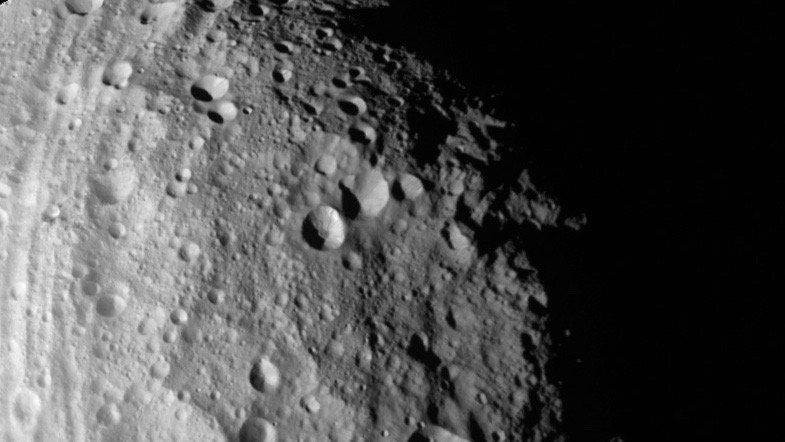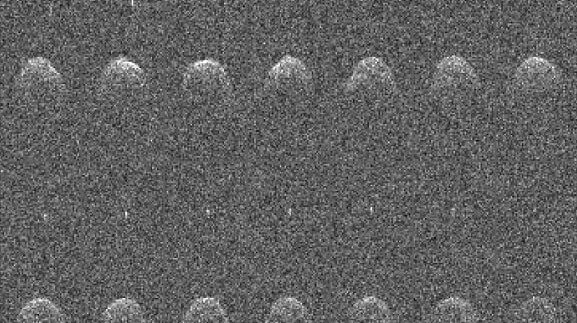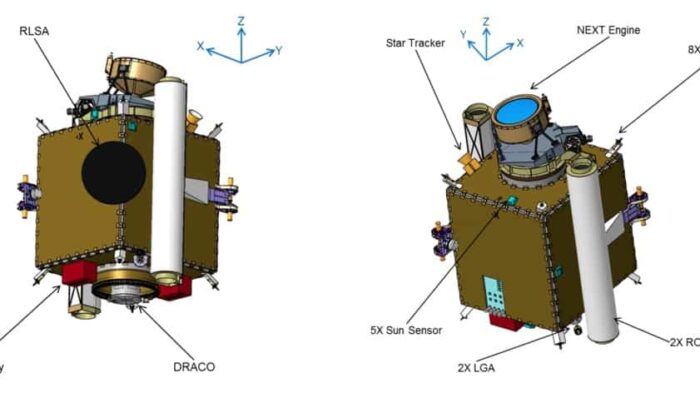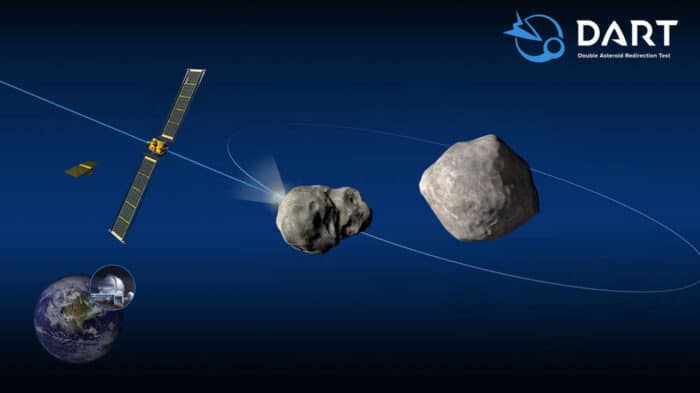In the 1997 movie Deep Impact, the world witnessed something everyone has feared for generations: an asteroid, on a collision course with Earth. This disaster movie presented an example of how nature can be hostile, and its devastating effects on humanity if we are not prepared. Luckily, in the real world, scientists are constantly searching for and studying these kinds of threats to Earth to prevent future catastrophes.
An example of one of these objects is 65803 Asteroid Didymos (1996 GT), or just Didymos. Didymos is 780 km in diameter and lies between the orbits of Earth and Mars --,--- away from Earth. Didymos is part of a binary asteroid system because it has its own moon named Dimorphos orbiting it. Dimorphos is 160 m in diameter, travelling at --,--- (--,---).
This binary asteroid system is currently at its closest point to Earth in its orbit, and it won’t be nearby again for another hundred or more years. While the paths of this system and Earth are not expected to ever cause the bodies to collide, because it is so close to Earth, it is classified as a near Earth object (NEO) and is a potential threat. NASA and ESA are collaborating on a mission called AIDA (Asteroid Impact and Deflection Assessment), to redirect Dimorphos and study the binary system.
Where is Asteroid Didymos now?
3D Web App
Mission Overview
The goal of this mission is to demonstrate our ability to change the trajectory of a NEO on collision course with Earth and study the aftereffects.
AIDA has two stages:
Stage 1: Asteroid Impactor – NASA’s Double Asteroid Redirection Test (DART)
The purpose of DART is to deflect Didymos’s moon, Dimorphos, using a technique called a “kinetic impact”. The DART probe will impact Dimorphos at 23,760 km/hr, causing it to redirect its path. Additionally alongside DART, will fly an Italian CubeSat called LICIACube to observe the impact.
Stage 2: Follow-up asteroid rendezvous spacecraft – ESA’s Hera
The next stage is a follow-up rendezvous visit to Dimorphos by Hera. Hera has two briefcase-sized CubeSats that will get close to the moon like drones. This visit will allow us to characterize the object in great detail by performing measurements on many physical properties of the moon. Hera will also analyze its new orbit and determine the effects of DART’s kinetic impact.
This two-part mission will provide valuable information that will prepare us for future planetary defense.
What Makes this Mission So Important
The AIDA mission is pretty much the subject of any sci-fi enthusiast’s fantasy. It’s not as exciting as a superhuman flying to space to stop it from reaching Earth or using a nuclear weapon to blow it to pieces. Instead, it’s a coordinated way of protecting Earth. If DART changes the trajectory of the asteroid even just by a little bit on the micro scale, that makes a big difference on the macro scale, decreasing the chances of collision. Dimorphos will be the first natural body in the solar system to have its orbit be shifted by human beings. Stage two of the AIDA mission, Hera, will be ushering in a new kind of technology by autonomously navigating around the asteroid. The planetary defense mission serves as a validation of new technologies such as deep space CubeSats, inter-satellite links, autonomous image-based navigation techniques and low-gravity operations.
Mission Status
The DART spacecraft from NASA was launched in November 2021 and successfully impacted Dimorphos on September 26th at 7:14 pm EDT. Below are DART’s final image before impact.
Using SpaceIn3D’s simulation of the solar system, you can currently track where Didymos is in its trajectory throughout our planetary neighborhood, in real time.
References:
1. “AIDA (mission)”
2. “Target asteroid – ESA”
3. “65803 Didymos”
4. “Double Asteroid Redirection Test (DART) Mission”
5. “Hera”
*This Interactive 3D Simulation is built on data provided by NASA JPL HORIZONS database for solar system objects and International Astronomical Union’s Minor Planet Center. Distances and speeds are estimates based on this data.
Photo Credit and other: NASA, ESO/S. Brunier, NASA/JHUAPL/SwRI, NASA/JPL-Caltech, JAXA, University of Tokyo & collaborators, UH/IA, Solar System Scope/INOVE CC BY 4.0, Wikipedia/Creative Commons Attribution-ShareAlike License, icons8.com, Péter Eke, NASA/Goddard/University of Arizona/Roman Tkachenko, Wikimedia Commons, Hayabusa 2 Arrival illustration by Akihiro Ikeshita (permission granted), oNline Web Fonts, Font Awesome, Galaxy vector created by stories – www.freepik.com






